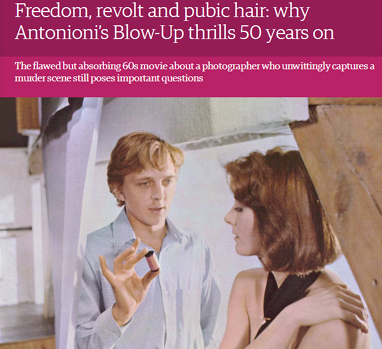IT IRRITATES W/SENSE OF ANTICLIMAX, "OF A ROAD NOT JUST MISSED, BUT REFUSED"-- YET IT STILL INTRIGUES
 The Guardian's Anthony Quinn looks at Blow-Up 50 years on:
The Guardian's Anthony Quinn looks at Blow-Up 50 years on:And here is where the film unfolds its most brilliant and memorable sequence, the part you want to watch over and over again. Alone in his dark room, our hero blows up the photos from the park and discovers that he may have recorded something other than a tryst. Cutting between the photographer and his pictures, Antonioni nudges us ever closer until we see the blow-ups as arrangements of light and shadow, a pointillistic swarm of dots and blots that may reveal a gunman in the bushes, and a body lying on the ground. Has he accidentally photographed a murder?Contemporary audiences watching the way Thomas, the photographer, storyboards his grainy images into “evidence” would surely have been reminded of Zapruder’s film of the Kennedy assassination in 1963: the same patient build-up, the same slow-motion shock. When Thomas returns to the park he does indeed find a corpse. It’s the grassy knoll moment. We feel both his confusion and his excitement at turning detective – he’s involved in serious work at last instead of debauching his talent on advertising and fashion. But, abruptly, his investigative work goes up in smoke.
Next morning, the photographs and the body have disappeared. The woman has gone, too. This links to larger fears of conspiracy, a sense that shadowy organisations are hovering in the background, covering up their crimes – and getting away with it.
Blow-Up looks back to Zapruder but also ahead to Watergate and a run of films that riffed in a similar manner to Antonioni, with his inquiring, cold-eyed lens: Gene Hackman, stealing privacy for a living as the surveillance genius in The Conversation (1974); witness elimination and the training of assassins by a corporation in The Parallax View (1974); later still, Brian de Palma’s homage to the sequence via John Travolta’s sound engineer in the near-namesake Blow Out (1981). But these sinister implications are not on the director’s mind. Where we anticipate a murder mystery, Antonioni balks us by posing a philosophical conundrum. “It is not about man’s relationship with man,” he said in an interview at the time, “it is about man’s relationship with reality.”
Having created the suspense, he declines to see it through and sends Thomas off on an enigmatic nocturnal wander – to a party where he gets stoned, to a nightclub full of zombified youth where, bafflingly, he makes off with a broken guitar. (The film’s other symbolic artefact is an aeroplane propeller he buys in an antique shop). Finally, and famously, he encounters a bunch of mime-faced rag-week students acting “crazy” and playing a game of imaginary tennis on an empty court. We even hear the thock of the tennis ball, though there isn’t one in sight. Antonioni seems to offer only a shrug: reality, illusion, who can tell the difference? Whenever I watch Blow-Up, I feel a sense of anticlimax, of a road not just missed, but refused. Yet as much as it irritates, it still intrigues, and asks a question that relates not merely to cinema but to any work of art: can we enjoy something even if we don’t “get” it?
Updated: Sunday, March 12, 2017 12:01 AM CST
Post Comment | Permalink | Share This Post



